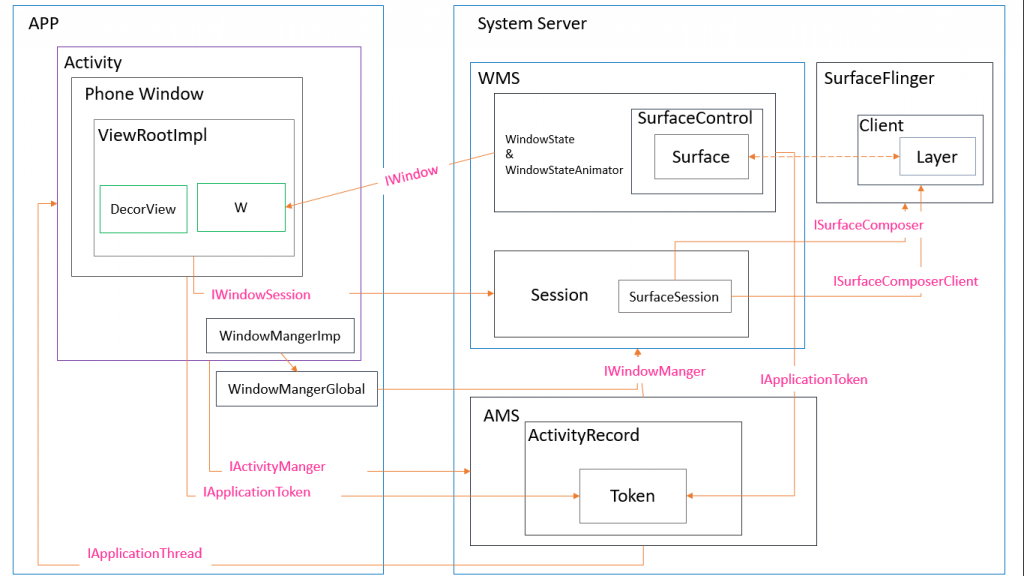android window(三)lWindow添加流程
http://androidxref.com/6.0.1_r10/xref/frameworks/base/services/core/java/com/android/server/wm/WindowManagerService.javahttp://androidxref.com/6.0.1_r10/xref/frameworks/base/core/java/android/view/WindowManagerImpl.javahttp://androidxref.com/6.0.1_r10/xref/frameworks/base/core/java/android/view/WindowManagerGlobal.javahttp://androidxref.com/6.0.1_r10/xref/frameworks/base/core/java/android/view/ViewRootImpl.javahttp://androidxref.com/6.0.1_r10/xref/frameworks/base/services/core/java/com/android/server/wm/WindowManagerService.javahttp://androidxref.com/6.0.1_r10/xref/frameworks/base/services/core/java/com/android/server/wm/Session.javahttp://androidxref.com/6.0.1_r10/xref/frameworks/base/core/java/android/view/IWindow.aidl
WindowManagerService只负责窗口管理,并不负责View的绘制跟图层混合,本文就来分析WMS到底是怎么管理窗口的。初接触Android时感觉:Activity似乎就是Google封装好的窗口,APP只要合理的启动新的Activity就打开了新窗口,这样理解没什么不对,Activity确实可以看做一种窗口及View的封装,不过从源码来看,Activity跟Window还是存在不同。本文主要从窗口的添加流程来将APP端、WMS端、SurfaceFlinger端三块串联起来,主要说一下几个方面
- 窗口的分类:Activity、Dialog、PopupWindow、Toast等对应窗口的区别
- Window、IWindow 、WindowState、WindowToken、AppToken等之间的关系
- 窗口的添加及Surface申请与Binder传递
窗口的分类简述
在Android系统中,PopupWindow、Dialog、Activity、Toast等都有窗口的概念,但又各有不同,Android将窗口大致分为三类:应用窗口、子窗口、系统窗口。其中,Activity与Dialog属于应用窗口、PopupWindow属于子窗口,必须依附到其他非子窗口才能存在,而Toast属于系统窗口,Dialog可能比较特殊,从表现上来说偏向于子窗口,必须依附Activity才能存在,但是从性质上来说,仍然是应用窗口,有自己的WindowToken,不同窗口之间的关系后面会更加详细的分析,这里有一个概念即可。
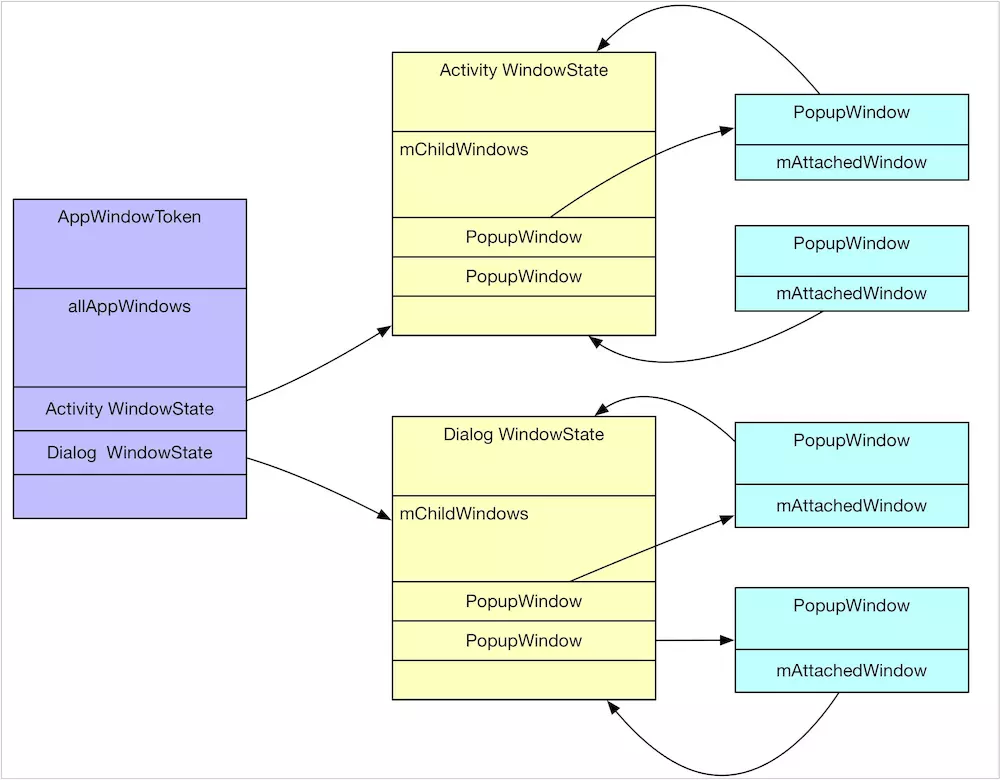
窗口的添加
Activity并不是View展示的唯一方式,分析窗口添加流程的话,Activity也并不是最好的例子,因为Activity还会牵扯到AMS的知识,这里我们不用Activity,而是用一个悬浮View的展示来分析窗口的添加,代码入下:
private void addTextViewWindow(Context context){
TextView mview=new TextView(context);
...//设置颜色 样式
//关键点1
WindowManager mWindowManager = (WindowManager) context.getApplicationContext().getSystemService(Context.WINDOW_SERVICE);
WindowManager.LayoutParams wmParams = new WindowManager.LayoutParams();
//关键点2
wmParams.type = WindowManager.LayoutParams.TYPE_TOAST;
wmParams.format = PixelFormat.RGBA_8888;
wmParams.width = 800;
wmParams.height = 800;
//关键点3
mWindowManager.addView(mview, wmParams);
}
@Override
public Object getSystemService(String name) {
return SystemServiceRegistry.getSystemService(this, name);
}
SystemServiceRegistry类用静态字段及方法中封装了一些服务的代理,其中就包括WindowManagerService
public static Object getSystemService(ContextImpl ctx, String name) {
ServiceFetcher<?> fetcher = SYSTEM_SERVICE_FETCHERS.get(name);
return fetcher != null ? fetcher.getService(ctx) : null;
}
static {
...
registerService(Context.WINDOW_SERVICE, WindowManager.class,
new CachedServiceFetcher<WindowManager>() {
@Override
public WindowManager createService(ContextImpl ctx) {
return new WindowManagerImpl(ctx.getDisplay());
}});
...
}
因此context.getApplicationContext().getSystemService()最终可以简化为new WindowManagerImpl(ctx.getDisplay()),下面看下WindowManagerImpl的构造方法,它有两个实现方法,对于Activity跟Application其实是有区别的,这点后面分析:
http://androidxref.com/6.0.1_r10/xref/frameworks/base/core/java/android/view/WindowManagerImpl.java
public WindowManagerImpl(Display display) {
this(display, null);
}
private WindowManagerImpl(Display display, Window parentWindow) {
mDisplay = display;
mParentWindow = parentWindow;
}
@Override
public void addView(@NonNull View view, @NonNull ViewGroup.LayoutParams params) {
applyDefaultToken(params);
mGlobal.addView(view, params, mDisplay, mParentWindow);
}
不过很明显WindowManagerImpl最后是委托mGlobal来进行这项操作,WindowManagerGlobal是一个单利,一个进程只有一个:
接着看WindowManagerGlobal的addView,对于添加系统窗口,这里将将代码精简一下,不关系子窗口等之类的逻辑
public void addView(View view, ViewGroup.LayoutParams params,
//... final WindowManager.LayoutParams wparams = (WindowManager.LayoutParams) params;
if (parentWindow != null) {
parentWindow.adjustLayoutParamsForSubWindow(wparams);
} else {
// If there's no parent, then hardware acceleration for this view is
// set from the application's hardware acceleration setting.
final Context context = view.getContext();
if (context != null
&& (context.getApplicationInfo().flags
& ApplicationInfo.FLAG_HARDWARE_ACCELERATED) != 0) {
wparams.flags |= WindowManager.LayoutParams.FLAG_HARDWARE_ACCELERATED;
}
} ViewRootImpl root;
View panelParentView = null; synchronized (mLock) {
//...
root = new ViewRootImpl(view.getContext(), display); view.setLayoutParams(wparams); mViews.add(view);
mRoots.add(root);
mParams.add(wparams);
} // do this last because it fires off messages to start doing things
try {
root.setView(view, wparams, panelParentView);
} catch (RuntimeException e) {
//...
}
}
http://androidxref.com/6.0.1_r10/xref/frameworks/base/core/java/android/view/ViewRootImpl.java
public void setView(View view, WindowManager.LayoutParams attrs, View panelParentView) {
synchronized (this) {
if (mView == null) {
mView = view;
...
//关键点1
// Schedule the first layout -before- adding to the window
// manager, to make sure we do the relayout before receiving
// any other events from the system.
requestLayout();
if ((mWindowAttributes.inputFeatures
& WindowManager.LayoutParams.INPUT_FEATURE_NO_INPUT_CHANNEL) == 0) {
mInputChannel = new InputChannel();
}
try {
//关键点2
res = mWindowSession.addToDisplay(mWindow, mSeq, mWindowAttributes,
getHostVisibility(), mDisplay.getDisplayId(),
mAttachInfo.mContentInsets, mAttachInfo.mStableInsets,
mAttachInfo.mOutsets, mInputChannel);
} catch (RemoteException e) {
...
}
}
http://androidxref.com/6.0.1_r10/xref/frameworks/base/core/java/android/view/ViewRootImpl.java
public ViewRootImpl(Context context, Display display) {
mContext = context;
mWindowSession = WindowManagerGlobal.getWindowSession();
mWindow = new W(this);
}
static class W extends IWindow.Stub {
private final WeakReference<ViewRootImpl> mViewAncestor;
private final IWindowSession mWindowSession;
W(ViewRootImpl viewAncestor) {
mViewAncestor = new WeakReference<ViewRootImpl>(viewAncestor);
mWindowSession = viewAncestor.mWindowSession;
}
@Override
public void resized(Rect frame, Rect overscanInsets, Rect contentInsets,
Rect visibleInsets, Rect stableInsets, Rect outsets, boolean reportDraw,
Configuration newConfig) {
final ViewRootImpl viewAncestor = mViewAncestor.get();
if (viewAncestor != null) {
viewAncestor.dispatchResized(frame, overscanInsets, contentInsets,
visibleInsets, stableInsets, outsets, reportDraw, newConfig);
}
}
@Override
public void moved(int newX, int newY) {
final ViewRootImpl viewAncestor = mViewAncestor.get();
if (viewAncestor != null) {
viewAncestor.dispatchMoved(newX, newY);
}
}
@Override
public void dispatchAppVisibility(boolean visible) {
final ViewRootImpl viewAncestor = mViewAncestor.get();
if (viewAncestor != null) {
viewAncestor.dispatchAppVisibility(visible);
}
}
@Override
public void dispatchGetNewSurface() {
final ViewRootImpl viewAncestor = mViewAncestor.get();
if (viewAncestor != null) {
viewAncestor.dispatchGetNewSurface();
}
}
@Override
public void windowFocusChanged(boolean hasFocus, boolean inTouchMode) {
final ViewRootImpl viewAncestor = mViewAncestor.get();
if (viewAncestor != null) {
viewAncestor.windowFocusChanged(hasFocus, inTouchMode);
}
}
private static int checkCallingPermission(String permission) {
try {
return ActivityManagerNative.getDefault().checkPermission(
permission, Binder.getCallingPid(), Binder.getCallingUid());
} catch (RemoteException e) {
return PackageManager.PERMISSION_DENIED;
}
}
@Override
public void executeCommand(String command, String parameters, ParcelFileDescriptor out) {
final ViewRootImpl viewAncestor = mViewAncestor.get();
if (viewAncestor != null) {
final View view = viewAncestor.mView;
if (view != null) {
if (checkCallingPermission(Manifest.permission.DUMP) !=
PackageManager.PERMISSION_GRANTED) {
throw new SecurityException("Insufficient permissions to invoke"
+ " executeCommand() from pid=" + Binder.getCallingPid()
+ ", uid=" + Binder.getCallingUid());
}
OutputStream clientStream = null;
try {
clientStream = new ParcelFileDescriptor.AutoCloseOutputStream(out);
ViewDebug.dispatchCommand(view, command, parameters, clientStream);
} catch (IOException e) {
e.printStackTrace();
} finally {
if (clientStream != null) {
try {
clientStream.close();
} catch (IOException e) {
e.printStackTrace();
}
}
}
}
}
}
@Override
public void closeSystemDialogs(String reason) {
final ViewRootImpl viewAncestor = mViewAncestor.get();
if (viewAncestor != null) {
viewAncestor.dispatchCloseSystemDialogs(reason);
}
}
@Override
public void dispatchWallpaperOffsets(float x, float y, float xStep, float yStep,
boolean sync) {
if (sync) {
try {
mWindowSession.wallpaperOffsetsComplete(asBinder());
} catch (RemoteException e) {
}
}
}
@Override
public void dispatchWallpaperCommand(String action, int x, int y,
int z, Bundle extras, boolean sync) {
if (sync) {
try {
mWindowSession.wallpaperCommandComplete(asBinder(), null);
} catch (RemoteException e) {
}
}
}
/* Drag/drop */
@Override
public void dispatchDragEvent(DragEvent event) {
final ViewRootImpl viewAncestor = mViewAncestor.get();
if (viewAncestor != null) {
viewAncestor.dispatchDragEvent(event);
}
}
@Override
public void dispatchSystemUiVisibilityChanged(int seq, int globalVisibility,
int localValue, int localChanges) {
final ViewRootImpl viewAncestor = mViewAncestor.get();
if (viewAncestor != null) {
viewAncestor.dispatchSystemUiVisibilityChanged(seq, globalVisibility,
localValue, localChanges);
}
}
@Override
public void onAnimationStarted(int remainingFrameCount) {
final ViewRootImpl viewAncestor = mViewAncestor.get();
if (viewAncestor != null) {
viewAncestor.dispatchWindowAnimationStarted(remainingFrameCount);
}
}
@Override
public void onAnimationStopped() {
final ViewRootImpl viewAncestor = mViewAncestor.get();
if (viewAncestor != null) {
viewAncestor.dispatchWindowAnimationStopped();
}
}
@Override
public void dispatchWindowShown() {
final ViewRootImpl viewAncestor = mViewAncestor.get();
if (viewAncestor != null) {
viewAncestor.dispatchWindowShown();
}
}
}
public static IWindowSession getWindowSession() {
synchronized (WindowManagerGlobal.class) {
if (sWindowSession == null) {
try {
InputMethodManager imm = InputMethodManager.getInstance();
//关键点1
IWindowManager windowManager = getWindowManagerService();
//关键点2
sWindowSession = windowManager.openSession(
new IWindowSessionCallback.Stub() {
@Override
public void onAnimatorScaleChanged(float scale) {
ValueAnimator.setDurationScale(scale);
}
},
imm.getClient(), imm.getInputContext());
} catch (RemoteException e) {
Log.e(TAG, "Failed to open window session", e);
}
}
return sWindowSession;
}
}
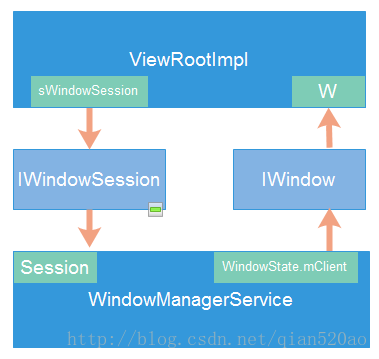
public static IWindowManager getWindowManagerService() {
synchronized (WindowManagerGlobal.class) {
if (sWindowManagerService == null) {
sWindowManagerService = IWindowManager.Stub.asInterface(
ServiceManager.getService("window"));
try {
sWindowManagerService = getWindowManagerService();
ValueAnimator.setDurationScale(sWindowManagerService.getCurrentAnimatorScale());
} catch (RemoteException e) {
Log.e(TAG, "Failed to get WindowManagerService, cannot set animator scale", e);
}
}
return sWindowManagerService;
}
}
@Override
public IWindowSession openSession(IWindowSessionCallback callback, IInputMethodClient client,
IInputContext inputContext) {
if (client == null) throw new IllegalArgumentException("null client");
if (inputContext == null) throw new IllegalArgumentException("null inputContext");
Session session = new Session(this, callback, client, inputContext);
return session;
}
到这里看到如何获取Session,下面就是利用Session来add一个窗口:其实是调用Session.java的addToDisplayWithoutInputChannel函数
final class Session extends IWindowSession.Stub
implements IBinder.DeathRecipient {
//...
@Override
public int addToDisplay(IWindow window, int seq, WindowManager.LayoutParams attrs,
int viewVisibility, int displayId, Rect outContentInsets, Rect outStableInsets,
Rect outOutsets, InputChannel outInputChannel) {
return mService.addWindow(this, window, seq, attrs, viewVisibility, displayId,
outContentInsets, outStableInsets, outOutsets, outInputChannel);
}
}

在WindowManager的LayoutParams中,与type同等重要的还有token。
上面说到:在源码中token一般代表的是Binder对象,作用于IPC进程间数据通讯。并且它也包含着此次通讯所需要的信息,在ViewRootImpl里,token用来表示mWindow(W类,即IWindow),并且在WmS中只有符合要求的token才能让Window正常显示。
如此一来,Window的添加请求就交给WmS去处理了,在WmS内部会为每一个应用保留一个单独的Session。在WmS 端会创建一个WindowState对象用来表示当前添加的窗口。 WmS负责管理这里些 WindowState 对象。至此,Window的添加过程就结束了。
至于Window的删除和更新过程,举一反三,也是使用WindowManagerGlobal对ViewRootImpl的操作,最终也是通过Session的IPC跨进程通信通知到WmS。整个过程的本质都是同出一辙的。
在WMS中addWindow又做了什么呢,就像名字写的,负责添加一个窗口,代码精简后如下:
public int addWindow(Session session, IWindow client, int seq,
WindowManager.LayoutParams attrs, int viewVisibility, int displayId,
Rect outContentInsets, Rect outStableInsets, Rect outOutsets,
InputChannel outInputChannel) {
...
synchronized(mWindowMap) {
...
//关键点1 不能重复添加
if (mWindowMap.containsKey(client.asBinder())) {
return WindowManagerGlobal.ADD_DUPLICATE_ADD;
}
//关键点2 对于子窗口类型的处理 1、必须有父窗口 2,父窗口不能是子窗口类型
if (type >= FIRST_SUB_WINDOW && type <= LAST_SUB_WINDOW) {
parentWindow = windowForClientLocked(null, attrs.token, false);
if (parentWindow == null) {
return WindowManagerGlobal.ADD_BAD_SUBWINDOW_TOKEN;
}
if (parentWindow.mAttrs.type >= FIRST_SUB_WINDOW
&& parentWindow.mAttrs.type <= LAST_SUB_WINDOW) {
return WindowManagerGlobal.ADD_BAD_SUBWINDOW_TOKEN;
}}
...
boolean addToken = false;
//关键点3 根据IWindow 获取WindowToken WindowToken是窗口分组的基础,每个窗口必定有一个分组-
WindowToken token = mTokenMap.get(attrs.token);
//关键点4对于Toast类系统窗口,其attrs.token可以看做是null, 如果目前没有其他的类似系统窗口展示,token仍然获取不到,仍然要走新建流程
if (token == null) {
...
token = new WindowToken(this, attrs.token, -1, false);
addToken = true;
}
...
//关键点5 新建WindowState,WindowState与窗口是一对一的关系,可以看做是WMS中与窗口的抽象实体
WindowState win = new WindowState(this, session, client, token,
attachedWindow, appOp[0], seq, attrs, viewVisibility, displayContent);
...
if (addToken) {
mTokenMap.put(attrs.token, token);
}
win.attach();
mWindowMap.put(client.asBinder(), win);
...
//关键点6
addWindowToListInOrderLocked(win, true);
return res;
}
这里有几个概念需要先了解下:
- IWindow:APP端窗口暴露给WMS的抽象实例,在ViewRootImpl中实例化,与ViewRootImpl一一对应,同时也是WMS向APP端发送消息的Binder通道。
- WindowState:WMS端窗口的令牌,与IWindow,或者说与窗口一一对应,是WMS管理窗口的重要依据。
- WindowToken:窗口的令牌,其实也可以看做窗口分组的依据,在WMS端,与分组对应的数据结构是WindowToken(窗口令牌),而与组内每个窗口对应的是WindowState对象,每块令牌(AppWindowToken、WindowToken)都对应一组窗口(WindowState),Activity与Dialog对应的是AppWindowToken,PopupWindow对应的是普通的WindowToken。
- AppToken:其实是ActivityRecord里面的IApplicationToken.Stub appToken 代理,也是ActivityClientRecord里面的token,可以看做Activity在其他服务(非AMS)的抽象
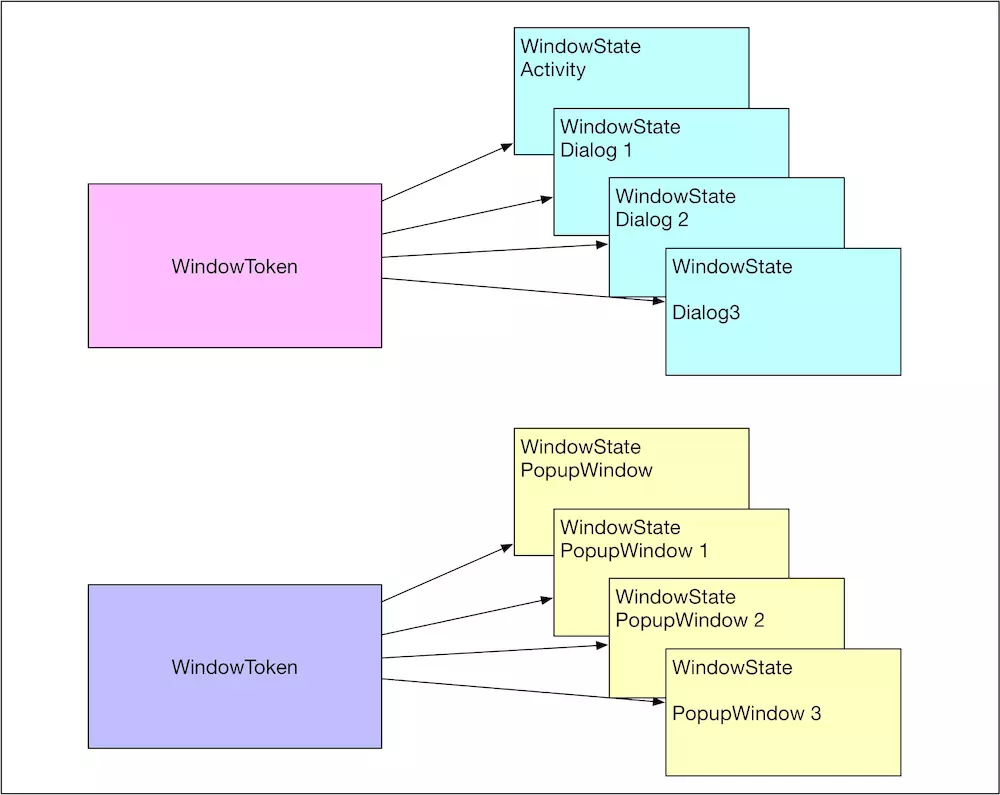
那么接着
关键点1:一个窗口不能被添加两次,IWindow是一个Binder代理,在WMS端,一个窗口只会有一个IWindow代理,这是由Binder通信机制保证的,这个对象不能被添加两次,否则会报错。
关键点2,如果是子窗口的话,父窗口必须已被添加,由于我们分析的是系统Toast窗口,可以先不用关心;
关键点3,WindowManager.LayoutParams中有一个token字段,该字段标志着窗口的分组属性,比如Activity及其中的Dialog是复用用一个AppToken,Activity里的PopupWindow复用一个IWindow类型Token,其实就是Activity的ViewRootImpl里面创建的IWindow,而对于我们现在添加的Toast类系统窗口,并未设置其attrs.token,那即是null,其实所有的Toast类系统窗口的attrs.token都可以看做null,就算不是null,也会在WMS被强制设置为null。所以Toast类系统窗口必定复用一个WindowToken,也可以说所有的Toast类系统窗口都是位于同一分组,这也是因为该类型系统窗口太常用,而且为所有进程服务,直接用一个WindowToken管理更加快捷,毕竟快速新建与释放WindowToken也算是一种开销。假设到我们添加系统窗口的时候,没有任何系统窗口展示,是获取不到key=null的WindowToken的,要新建WindowToken,并且添加到全局的TokenMap中,
而关键点5,其实就是新建窗口在WMS端的抽象实例:WindowState,它同窗口一一对应,详细记录了窗口的参数、Z顺序、状态等各种信息,新建只有会被放入全局的Map中,同时也会被附加到相应的WindowToken分组中去,到这里APP端向WMS注册窗口的流程就算走完了,不过只算完成了前半部分,WMS还需要向SurfaceFlinger申请Surface,才算完成真正的分配了窗口。在向SurfaceFlinger申请Surface之前,WMS端需要获得SF的代理,在WindowState对象创建后会利用 win.attach()函数为当前APP申请建立SurfaceFlinger的链接:
void attach() {
if (WindowManagerService.localLOGV) Slog.v(
mSession.windowAddedLocked();
}
void windowAddedLocked() {
if (mSurfaceSession == null) {
// SurfaceSession新建
mSurfaceSession = new SurfaceSession();
mService.mSessions.add(this);
...
}
mNumWindow++;
}
可以看到SurfaceSession对于Session来说是单利的,也就是与APP的Seesion一一对应,SurfaceSession所握着的SurfaceFlinger的代理其实就是SurfaceComposerClient,其实现如下:
public SurfaceSession() {
mNativeClient = nativeCreate();
}
static jlong nativeCreate(JNIEnv* env, jclass clazz) {
SurfaceComposerClient* client = new SurfaceComposerClient();
client->incStrong((void*)nativeCreate);
return reinterpret_cast<jlong>(client);
}
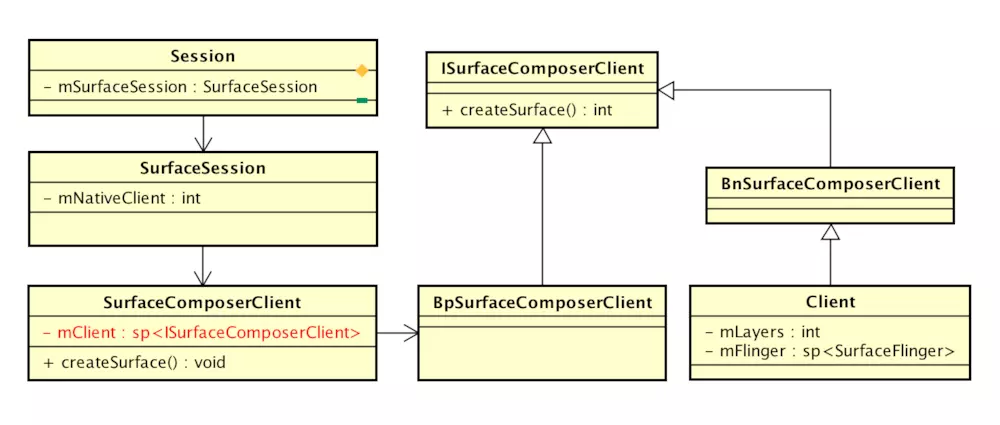
SurfaceComposerClient::SurfaceComposerClient()
: mStatus(NO_INIT), mComposer(Composer::getInstance())
{
}
// 单利的,所以只有第一次的时候采用
void SurfaceComposerClient::onFirstRef() {
sp<ISurfaceComposer> sm(ComposerService::getComposerService());
if (sm != 0) {
sp<ISurfaceComposerClient> conn = sm->createConnection();
if (conn != 0) {
mClient = conn;
mStatus = NO_ERROR;
}
}
} sp<ISurfaceComposerClient> SurfaceFlinger::createConnection()
{
sp<ISurfaceComposerClient> bclient;
sp<Client> client(new Client(this));
status_t err = client->initCheck();
if (err == NO_ERROR) {
bclient = client;
}
return bclient;
}
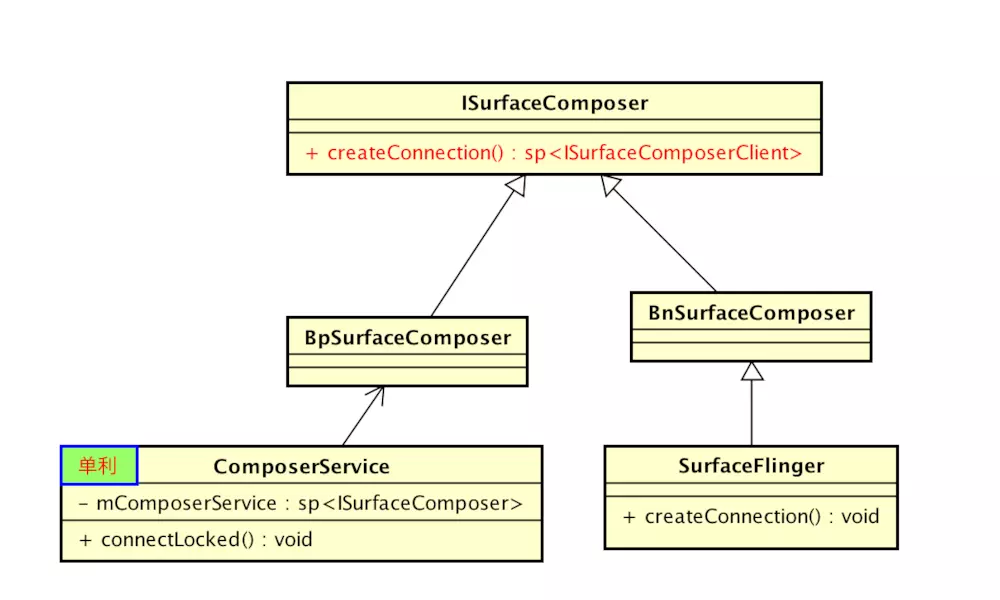
void scheduleTraversals() {
if (!mTraversalScheduled) {
mTraversalScheduled = true;
//关键点1 添加塞子
mTraversalBarrier = mHandler.getLooper().getQueue().postSyncBarrier();
//关键点2 添加异步消息任务
mChoreographer.postCallback(
Choreographer.CALLBACK_TRAVERSAL, mTraversalRunnable, null);
...
private void performTraversals() {
final View host = mView;
...
if (mFirst || windowShouldResize || insetsChanged ||
viewVisibilityChanged || params != null) {
//关键点1 申请Surface或者重新设置参数
relayoutResult = relayoutWindow(params, viewVisibility, insetsPending);
//关键点2 测量
performMeasure(childWidthMeasureSpec, childHeightMeasureSpec);
}
//关键点3 布局
performLayout(lp, desiredWindowWidth, desiredWindowHeight);
//关键点4 更新window
try {
mWindowSession.setInsets(mWindow, insets.mTouchableInsets,
contentInsets, visibleInsets, touchableRegion);
...
//关键点5 绘制
performDraw();
...
}
private int relayoutWindow(WindowManager.LayoutParams params, int viewVisibility,
boolean insetsPending) throws RemoteException {
...
int relayoutResult = mWindowSession.relayout(
mWindow, mSeq, params, ... mSurface);
...
return relayoutResult;
}
public int relayoutWindow(Session session, IWindow client, int seq,... Surface outSurface) {
WindowState win = windowForClientLocked(session, client, false);
WindowStateAnimator winAnimator = win.mWinAnimator;
//关键点1
SurfaceControl surfaceControl = winAnimator.createSurfaceLocked();
if (surfaceControl != null) {
//关键点2
outSurface.copyFrom(surfaceControl);
} else {
outSurface.release();
}
static jlong nativeCreate(JNIEnv* env, jclass clazz, jobject sessionObj,
jstring nameStr, jint w, jint h, jint format, jint flags) {
ScopedUtfChars name(env, nameStr);
//关键点1
sp<SurfaceComposerClient> client(android_view_SurfaceSession_getClient(env, sessionObj));
//关键点2
sp<SurfaceControl> surface = client->createSurface(
String8(name.c_str()), w, h, format, flags);
surface->incStrong((void *)nativeCreate);
return reinterpret_cast<jlong>(surface.get());
}
关键点1是取到SurfaceSession对象中SurfaceComposerClient对象,之后调用SurfaceComposerClient的createSurface方法进一步创建SurfaceControl,
sp<SurfaceControl> SurfaceComposerClient::createSurface(
const String8& name,
uint32_t w,
uint32_t h,
PixelFormat format,
uint32_t flags)
{
sp<SurfaceControl> sur;
if (mStatus == NO_ERROR) {
sp<IBinder> handle;
sp<IGraphicBufferProducer> gbp;
//关键点1 获取图层的关键信息handle, gbp
status_t err = mClient->createSurface(name, w, h, format, flags,
&handle, &gbp);
//关键点2 根据返回的图层关键信息 创建SurfaceControl对象
if (err == NO_ERROR) {
sur = new SurfaceControl(this, handle, gbp);
}
}
return sur;
}
status_t Client::createSurface(
const String8& name,
uint32_t w, uint32_t h, PixelFormat format, uint32_t flags,
sp<IBinder>* handle,
sp<IGraphicBufferProducer>* gbp){
...
//关键点2 这里并未直接创建 ,而是通过发送了一个MessageCreateLayer消息
sp<MessageBase> msg = new MessageCreateLayer(mFlinger.get(),
name, this, w, h, format, flags, handle, gbp);
mFlinger->postMessageSync(msg);
return static_cast<MessageCreateLayer*>( msg.get() )->getResult();
}
Client 并不会直接新建图层,而是向SurfaceFlinger发送一个MessageCreateLayer消息,通知SurfaceFlinger服务去执行,其handler代码如下:
class MessageCreateLayer : public MessageBase {
SurfaceFlinger* flinger;
Client* client;
virtual bool handler() {
result = flinger->createLayer(name, client, w, h, format, flags,
handle, gbp);
return true;
}
};
其实就是调用SurfaceFlinger的createLayer,创建一个图层,到这里才是真正的创建图层:
status_t SurfaceFlinger::createLayer(
const String8& name,
const sp<Client>& client,
uint32_t w, uint32_t h, PixelFormat format, uint32_t flags,
sp<IBinder>* handle, sp<IGraphicBufferProducer>* gbp)
{
if (int32_t(w|h) < ) {
return BAD_VALUE;
} status_t result = NO_ERROR; sp<Layer> layer;
//关键点1 新建不同图层
switch (flags & ISurfaceComposerClient::eFXSurfaceMask) {
case ISurfaceComposerClient::eFXSurfaceNormal:
result = createNormalLayer(client,
name, w, h, flags, format,
handle, gbp, &layer);
break;
case ISurfaceComposerClient::eFXSurfaceDim:
result = createDimLayer(client,
name, w, h, flags,
handle, gbp, &layer);
break;
default:
result = BAD_VALUE;
break;
} if (result != NO_ERROR) {
return result;
}
...
}
SurfaceFlinger会根据不同的窗口参数,创建不同类型的图层,这里只看一下createNormalLayer普通样式的图层,
status_t SurfaceFlinger::createNormalLayer(const sp<Client>& client,
const String8& name, uint32_t w, uint32_t h, uint32_t flags, PixelFormat& format,
sp<IBinder>* handle, sp<IGraphicBufferProducer>* gbp, sp<Layer>* outLayer)
{
// initialize the surfaces
switch (format) {
case PIXEL_FORMAT_TRANSPARENT:
case PIXEL_FORMAT_TRANSLUCENT:
format = PIXEL_FORMAT_RGBA_8888;
break;
case PIXEL_FORMAT_OPAQUE:
format = PIXEL_FORMAT_RGBX_8888;
break;
}
//关键点 1
*outLayer = new Layer(this, client, name, w, h, flags);
status_t err = (*outLayer)->setBuffers(w, h, format, flags);
//关键点 2
if (err == NO_ERROR) {
*handle = (*outLayer)->getHandle();
*gbp = (*outLayer)->getProducer();
}
return err;
}
可以看到 图层最终对应的是Layer,这里会新建一个Layer对象,Layer中包含着与这个图层对应的Handle及Producer对象,Handle可以看做是Surface的唯一性标识,不过好像没太大的作用,最多是一个标识,将来清理的时候有用。相比之下gbp = (*outLayer)->getProducer()比较重要,它实际是一个BufferQueueProducer对象,关系到共享内存的分配问题,后面会专门分析,这里到此打住,我们终于得到了一个图层对象,到这里之后,我们梳理一下,图层如何建立的:
- 首先APP端新建一个Surface图层的容器壳子,
- APP通过Binder通信将这个Surface的壳子传递给WMS,
- WMS为了填充Surface去向SurfaceFlinger申请真正的图层,
- SurfaceFlinger收到WMS请求为APP端的Surface分配真正图层
- 将图层相关的关键信息Handle及Producer传递给WMS
Layer建立之后,SurfaceFlinger会将图层标识信息Handle及Producer传递给WMS,WMS利用这两者创建一个SurfaceControl对象,之后再利用该对象创建Surface,具体代码如下:
void getSurface(Surface outSurface) {
outSurface.copyFrom(mSurfaceControl);
}
public void copyFrom(SurfaceControl other) {
long surfaceControlPtr = other.mNativeObject;
long newNativeObject = nativeCreateFromSurfaceControl(surfaceControlPtr);
synchronized (mLock) {
setNativeObjectLocked(newNativeObject);
}
}
可以看到Surface的拷贝函数其实就是直接修改Surface native对象指针值,native的Surface对象中包含mGraphicBufferProducer对象,很重要,会被传递给APP端。
static jlong nativeCreateFromSurfaceControl(JNIEnv* env, jclass clazz,
jlong surfaceControlNativeObj) { sp<SurfaceControl> ctrl(reinterpret_cast<SurfaceControl *>(surfaceControlNativeObj));
sp<Surface> surface(ctrl->getSurface());
if (surface != NULL) {
surface->incStrong(&sRefBaseOwner);
}
return reinterpret_cast<jlong>(surface.get());
} sp<Surface> SurfaceControl::getSurface() const
{
Mutex::Autolock _l(mLock);
if (mSurfaceData == ) {
mSurfaceData = new Surface(mGraphicBufferProducer, false);
}
return mSurfaceData;
}
到这里WMS端Surface创建及填充完毕,并且Surface其实与WMS的SurfaceControl一一对应,当APP端需要在图层级别进行操控的时候,其实还是要依靠SurfaceControl的,WMS的Surface创建完毕后,需要传递给APP端,之后APP端就获得直接同SurfaceFlinger通信的能力,比如绘图与UI更新,怎传递的呢?我们知道Surface实现了Parcel接口,因此可以传递序列化的数据,其实看一下Surface nativeReadFromParcel就知道到底是怎么传递的了,利用readStrongBinder获取IGraphicBufferProducer对象的句柄,之后转化为IGraphicBufferProducer代理其实就是BpGraphicBufferProducer,之后利用BpGraphicBufferProducer构建Surface,这样APP端Surface就被填充完毕,可以同SurfaceFlinger通信了:
static jlong nativeReadFromParcel(JNIEnv* env, jclass clazz,
jlong nativeObject, jobject parcelObj) {
Parcel* parcel = parcelForJavaObject(env, parcelObj);
if (parcel == NULL) {
doThrowNPE(env);
return ;
}
sp<Surface> self(reinterpret_cast<Surface *>(nativeObject));
sp<IBinder> binder(parcel->readStrongBinder());
if (self != NULL
&& (IInterface::asBinder(self->getIGraphicBufferProducer()) == binder)) {
return jlong(self.get());
}
sp<Surface> sur;
sp<IGraphicBufferProducer> gbp(interface_cast<IGraphicBufferProducer>(binder));
if (gbp != NULL) {
sur = new Surface(gbp, true);
sur->incStrong(&sRefBaseOwner);
} if (self != NULL) {
self->decStrong(&sRefBaseOwner);
} return jlong(sur.get());
}
到这里为止,APP<->WMS <->WMS 通信申请Surface的流程算走完了
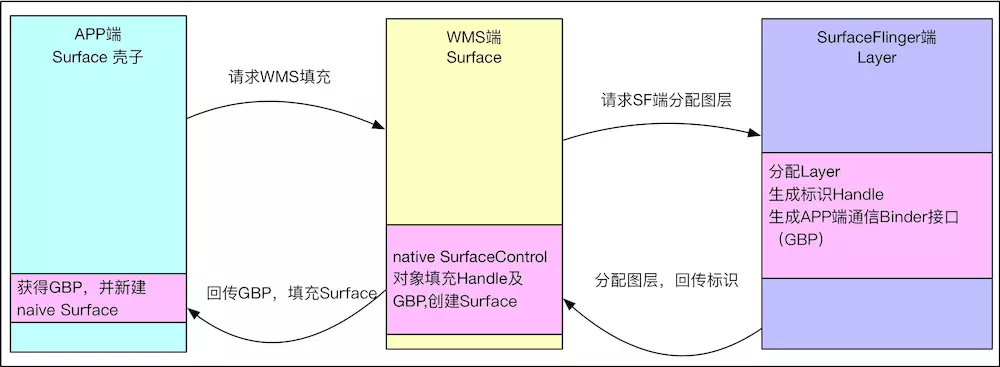
总结
窗口的添加流程简化如下,这里暂且忽略窗口的分组管理。
- APP首先去WMS登记窗口
- WMS端登记窗口
- APP新建Surface壳子,请求WMS填充Surface
- WMS请求SurfaceFlinger分配窗口图层
- SurfaceFlinger分配Layer,将结果回传给WMS
- WMS将窗口信息填充到Surface传输到APP
- APP端获得填充信息,获取与SurfaceFlinger通信的能力
android window(三)lWindow添加流程的更多相关文章
- Android Studio 三种添加插件的方式,androidstudio
前几篇blog我们介绍了如何安装和配置Android Studio,这篇Blog我们来聊聊如何给Android Studio添加插件,添加插件的路径有三种,我把他们分类如下: 点击设置小按钮 点击[P ...
- android View层的绘制流程
还记得前面<Android应用setContentView与LayoutInflater加载解析机制源码分析>这篇文章吗?我们有分析到Activity中界面加载显示的基本流程原理,记不记得 ...
- Android View的加载流程
什么是Activity? Activity是 用户操作的可视化界面:它为用户提供了一个放置视图和交互操作的窗口.采用setContentView的方法提供.因此,可以理解Activity.Window ...
- 深入理解 Android 之 View 的绘制流程
概述 本篇文章会从源码(基于Android 6.0)角度分析Android中View的绘制流程,侧重于对整体流程的分析,对一些难以理解的点加以重点阐述,目的是把View绘制的整个流程把握好,而对于特定 ...
- Android中Linux suspend/resume流程
Android中Linux suspend/resume流程首先我们从linux kernel 的suspend说起,不管你是使用echo mem > /sys/power/state 或者使用 ...
- Android 7.1 屏幕旋转流程分析
Android 7.1 屏幕旋转流程分析 一.概述 Android屏幕的旋转在framework主要涉及到三个类,结构如图 PhoneWindowManager:为屏幕的横竖屏转换的管理类. Wi ...
- 【转】深入理解Android之View的绘制流程
概述 本篇文章会从源码(基于Android 6.0)角度分析Android中View的绘制流程,侧重于对整体流程的分析,对一些难以理解的点加以重点阐述,目的是把View绘制的整个流程把握好,而对于特定 ...
- Android之View的绘制流程
本篇文章会从源码(基于Android 6.0)角度分析Android中View的绘制流程,侧重于对整体流程的分析,对一些难以理解的点加以重点阐述,目的是把View绘制的整个流程把握好,而对于特定实现细 ...
- [转载]在Android C/C++层添加LOG调试
原文地址:C/C++层添加LOG调试">在Android C/C++层添加LOG调试作者:谢轩昂 在Android C/C++层添加LOG调试,并且在Logcat中输出的方法 第一步: ...
随机推荐
- arcgis server10.2发布地图服务报错
发布地图服务时,读取了本机电脑中的切片方案.发布服务,报打包成功,但发布失败错误. 解决办法:给arcgis账户,赋予读写权限即可.重复发布服务,成功发布.
- Python 循环异或对文件进行加解密
# -* -coding: UTF-8 -* - # 功能:异或方式对文件进行加密和解密 import os import datetime # 主函数 def main(): getInput() ...
- Linux--Linux的网络--05
一层: HUB --- 集线器 总线型结构,使用泛洪方式 二层: 在早期,pc通信只需要MAC地址进行数据转发 网桥 --- 交换机 :维护MAC地址表 三层: 网络的增大,就需要逻辑地址(IP地址 ...
- Python自动化学习--批量执行.py用例
这段时间在摸索自动化,学到执行测试用例的时候发现,执行单用例的时候很简单,如果想多条用例执行的话就没那么简单了,经过几番查找,找到如下方法: unittest模块中的TestLoader类有一个dis ...
- vb6中word编程总结
1,在project\references 中加入microsoft word 9.0 object library 2, 启动word Dim wApp As Word.Application ...
- Maven Pom文件标签详解
<span style="padding:0px; margin:0px"><project xmlns="http://maven.apache.or ...
- web页面调用app的方法
use_app_goto_page: (skip_type, skip_target) => { // Android App if (/android/i.test(navigator.use ...
- 【SaltStack官方版】—— states教程, part 4 - states 说明
STATES TUTORIAL, PART 4 本教程建立在第1部分.第2部分.第3部分涵盖的主题上.建议您从此开始.这章教程我们将讨论更多 sls 文件的扩展模板和配置技巧. This part o ...
- c++ string去除左右空格
res.substr(res.find_first_not_of(' '),res.find_last_not_of(' ') + 1)
- flask入门,Hello World!
flask这个框架简单易用,去年2018的使用份额已经快接近django了.入门首选,没有太多的要求. 接下来,写个Hello World吧 1.新手入门,如果你是在windows下使用的,需要先安装 ...

